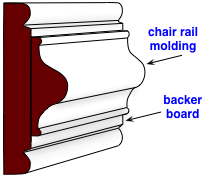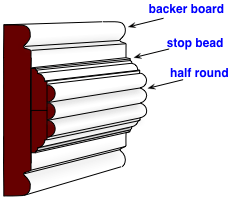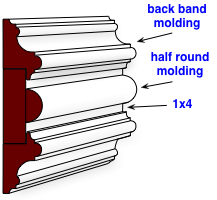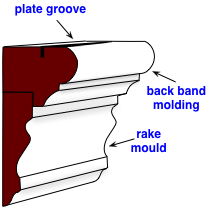Chair Rail Design Ideas
by: Dale Cox
This page contains some ideas for building chair rails by stacking 2 or more separate trim molding profiles to simulate historic designs and create new ones. Included here are some narrow and wide profiles, as well as ideas for a display shelf and wainscoting cap.
Two-Piece Chair Rail

This is a simple, easy to build design made by stacking a small milled chair rail profile on top of a broader backer board. This is a specially made backer but you could also use two, one-piece baseboards or door casings and butt them at the middle to expose the decorative edges.
To install this design, the back board is nailed to the framing first using 2 or 2½in finishing nails to fasten it to the wall studs along the center so the holes will be covered by the top molding piece. The top piece is then nailed to the backer board using shorter, 1 to 1½in nails. Apply caulking where the trim pieces meet and fill exposed nail holes with painter's putty or window glaze.
Three-Piece Chair Rail

This chair rail is built using a backer board, a stop bead profile and half-round bead molding. The half-round can be single pieces or simulated with a one-piece reed. This design, like most combination moldings, can be changed by using different trim profiles for one or all members. Install with nails along the center of the backer board and then assemble the stop bead and half-round using wood glue and nails.
Victorian Chair Rail

The curls and coves in the back band in this profile creates a Victorian style chair rail. This can be made wider using a 1x6 or 1x8 instead of the 1x4 used here. Add more half-rounds or use a different, more ornate molding along the middle of wider designs for a more dramatic trim.
To install this, the 1x4 is nailed to the framing with 2 or 2½in nails. Shorter nails are then used to attach the back band and the half-round to the 1by.
Reed Chair Rail

This design is built using a one-piece reed profile, and 2 pieces of panel molding along the top and bottom edges. This is another wide, elaborate chair rail suitable for large rooms with high ceilings.
The nails are driven at the top of the arches in the profile to make filling the holes easier and less noticeable in the finish. Apply a thin coat of wood glue to the contacting edges of the molding and drive the nails into the wall framing. Caulking shouldn't be needed between the trim pieces in this design.

Ledge Chair Rail
This design is created using a large piece of bead or bullnose, a one-piece baseboard, and a cove molding.
This profile can be installed flat against the wall, as a chair rail, or set out to cap wood wainscoting in a dining room or ceramic tile in a bathroom. A wider bullnose bead will probably be needed when covering thick materials. Install the baseboard first and then add the bullnose followed by the cove.
Plate Rail Molding

This is similar to the one above but with a groove cut along the top of a large piece of back band that caps the design. The groove will serve as a stop for displaying decorative plates and similar tchotchkes. The tail of the profile is created using a large piece or rake mould to give it a little flare.
Build this profile by nailing the rake to the framing and then setting the back band along the top. Nail the top piece at an angle into the lower piece and the wall frame using 2 or 2½in finishing nails. Caulk shouldn't be required at the molding joint but the nail holes should be filled before painting.
 Baseboard Designs
Baseboard Designs Building Stacked Moldings
Building Stacked Moldings